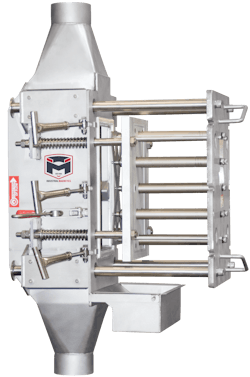Using separation magnets in pneumatic conveying systems

From plastics to pharmaceuticals, pneumatic conveying lines keep bulk materials moving smoothly. However, these lines can also transport unseen ferrous metal contamination from equipment wear or raw material suppliers. These harmful fragments can originate internally as fine particles from wearing machinery components such as mixers and grinders or even as larger pieces breaking free due to equipment stress. Contamination can also enter the system externally, potentially arriving within raw materials received from suppliers containing small metal debris or introduced accidentally as nuts, bolts, or wire clippings during routine maintenance activities. Left unchecked, these metal fragments pose risks to consumers, equipment, and a company's reputation — a constant concern for operations and facility leaders. Integrating separation magnets is a strong solution to protect products, people, and profits.
Why are magnets needed?
Failing to integrate magnetic separation leaves pneumatic processing lines unprotected against several key threats stemming from metal contamination. Separation magnets are specifically designed to capture a wide spectrum of ferrous materials — ranging from fine particles to larger tramp metal fragments composed of mild steel and carbon steel. It is important to note that industrial magnets attract ferrous metals and are generally ineffective against non-ferrous materials such as aluminum or many common stainless-steel alloys, though specialized magnetic systems may exist for certain applications.
This ferrous contamination, if left unchecked, can jeopardize product purity and lead to costly equipment damage. Furthermore, these stray ferrous particles create potential safety risks for personnel and end-users, including the serious danger of sparking a combustion event within the system. By proactively removing tramp metal, separation magnets not only address these issues but also serve as crucial insurance against product recalls and the associated negative publicity that can damage a brand.
Types of magnets and how they work
When selecting an industrial magnet supplier to work with, partnering with a supplier that has expertise in both magnetic products and application specifics is crucial. This expertise ensures a correct assessment of a company’s process requirements, leading to the optimal magnetic separator recommendation for protecting both equipment and product purity. While the most effective separation comes from solutions tailored to the specific process, there are types of magnets that are more commonly incorporated in pneumatic conveying.
Primary among these are inline magnets, which are designed for direct installation within the pneumatic system itself. In these systems, the flow of air-conveyed materials, such as powders and granules, moves directly through the magnetic separator. Common inline designs include bullet magnets (also called center-flow magnets) and specialized housings containing magnetic tubes (often configured like inline grate magnets) adapted for pneumatic flow. Additionally, other effective designs such as plate magnets can be integrated into specific inline housings or applied at different points within the conveying system.
Understanding how application-specific traits impact magnetic system selection is essential. Key factors demanding careful consideration include:
Product flow rate. Higher flow rates reduce the material's exposure time to the magnet, potentially requiring stronger magnetic fields or specific designs to ensure effective capture.
Operating temperature. Magnets can permanently lose strength if they operate above their temperature rating. Knowing the full process temperature range (minimum, maximum, typical) is critical for selecting appropriate magnet materials (e.g., standard vs. high-temperature grades) that maintain performance without degrading.
Product characteristics. Product type, size, and density all impact how the material flows through or around the magnet. Additionally, abrasive products have the potential to wear magnet components. Moist or sticky materials can cause buildup or change cleaning needs depending on what magnet is in use.
While a magnet supplier should guide a buyer through these points, being prepared with this information is beneficial. Providing details about the process streamlines the selection process, potentially saving time and ensuring a more effective solution.
System and installation parameters
Critical installation questions include: Does the magnet match the conveying line size and meet pressure ratings? How will the magnet be oriented (vertical, horizontal, angled)? Are specific sanitary requirements (materials, finishes) necessary? Is there adequate access for cleaning and maintenance? Answering these questions ensures that the chosen system integrates properly and functions effectively within a pneumatic line.
To determine the most effective system, an industrial magnet supplier should address these questions. Companies are not assumed to have specialized knowledge, but a thorough understanding of the application and providing relevant information can make processes more efficient and reduce delays.
Separation magnet installation
The purchasing facility’s team generally handles installation of the magnetic separator. This practice allows control over scheduling, allowing the work to coincide with planned maintenance or shutdowns to minimize operational disruption. Although the facility manages the installation, it is important to note that many magnet suppliers have experts available to provide onsite support and guidance throughout the process if required. Most installations can be completed efficiently within a typical scheduled downtime window.
Operation and maintenance
Regular maintenance and cleaning are essential for optimal magnetic separation equipment performance. While the ideal cleaning frequency varies based on application factors such as contamination load and product type, neglecting this routine maintenance leads to significant problems. Insufficient cleaning allows captured metal and product to build up. This buildup not only reduces the magnet's separation efficiency over time but can also physically damage components.
For instance, accumulation around gaskets can cause premature wear, leading to poor sealing and potentially allowing product to leak or “blow out” of the system. Furthermore, abrasive products or improper cleaning can eventually wear down the magnetic elements themselves (such as the tubes in a grate magnet), potentially requiring costly, earlier-than-expected replacement of the unit. Therefore, adhering to a suitable cleaning schedule based on specific operating conditions is critical for sustained performance and equipment longevity.
The ease and efficiency of this task can be significantly improved by selecting the right magnet design. For example, automated or self-cleaning magnet designs, such as certain drawer-in-housing models, allow operators to initiate cleaning cycles remotely or automatically. These systems can quickly discharge captured metal without requiring manual intervention inside the housing, proving especially useful in hard-to-reach installations or highly automated processes. This approach minimizes cleaning downtime and helps ensure that the magnet consistently performs at its best.
A critical line of defense
Effective integration of the correct magnetic solution is crucial for product purity and ultimately minimizing equipment downtime. Separation magnets in pneumatic processing lines need to be engineered based on the flow rate, bulk density, characteristics of the product flow, line pressure, and the properties of the metal that must be captured. The magnets that get put into use are the critical line of defense as they capture metal fragments that enter the product flow.
It is essential that industrial magnet companies assess these factors when determining the correct solution for a given application. Success involves understanding contamination risks, carefully selecting the appropriate magnet design based on key application factors and collaborating with knowledgeable suppliers. Proper installation during planned downtime and, most importantly, a commitment to regular, diligent maintenance and cleaning based on operating conditions are essential to ensure sustained protection and optimal performance. By addressing these critical elements, companies can confidently mitigate the risks associated with ferrous metal contamination.
Industrial Magnetics
About the Author

Chris Waibel
Chris Waibel is Tramp Metal and Automation product coordinator at Industrial Magnetics a leading manufacturer of industrial magnets based in Boyne City, Michigan.

Emma Vondra
Emma Vondra is marketing content specialist at Industrial Magnetics a leading manufacturer of industrial magnets based in Boyne City, Michigan.


